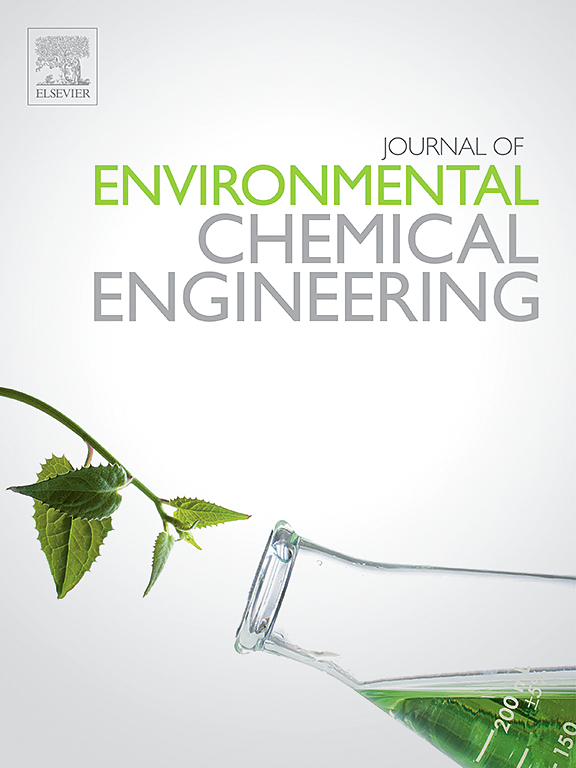Feasibility of UVC-LED/H2O2 advanced oxidation processes as a hybrid water treatment system uniting secondary battery and microbial fuel cell
IF 7.4
2区 工程技术
Q1 ENGINEERING, CHEMICAL
引用次数: 0
Abstract
An innovative hybrid water treatment system consisting of an ultraviolet C light-emitting diode sequentially connected to a secondary battery and microbial fuel cells was developed and systematically optimized via an electrochemical performance test. According to standardized bio-dosimetry, the generated ultraviolet intensity powered by a pre-charged battery was determined to be 2.3×10−1 μW cm−2. The quantified UV intensity was used in calculating the fundamental kinetic parameters for the inactivation of microbial entities and the degradation of organic pollutants during UVC-LED and UVC-LED/H2O2 treatment processes. The fluence-based first-order rate constants were 1.07 and 2.43 cm2/mJ for Escherichia coli and 0.10 and 0.18 cm2/mJ for MS-2 bacteriophage, respectively. The study detected 2.76–8.00×10−16 M hydroxyl radicals at steady-state during UVC-LED/H2O2 treatment with 0.3–1 mM H2O2. The second-order rate constant for atrazine during UVC-LED/H2O2 treatment was 1.90×109 M−1 s−1 according to linear regression analysis of atrazine elimination over •OH exposure. This comprehensive investigation expands the application of microbial electrochemical systems in water treatment, providing a fundamental kinetic dataset for quantifying and predicting the microbial and (persistent) organic pollutants abatement.
紫外线-LED/H2O2 高级氧化工艺作为联合二次电池和微生物燃料电池的混合水处理系统的可行性
我们开发了一种创新的混合水处理系统,该系统由紫外线 C 发光二极管和二次电池及微生物燃料电池依次连接组成,并通过电化学性能测试进行了系统优化。根据标准化的生物剂量学,由预充电电池供电产生的紫外线强度被确定为 2.3×10-1 μW cm-2。量化的紫外线强度用于计算紫外线-LED 和紫外线-LED/H2O2 处理过程中微生物灭活和有机污染物降解的基本动力学参数。对大肠杆菌而言,基于通量的一阶速率常数分别为 1.07 和 2.43 cm2/mJ,对 MS-2 噬菌体而言,分别为 0.10 和 0.18 cm2/mJ。在 UVC-LED/H2O2 处理 0.3-1 mM H2O2 的过程中,该研究检测到 2.76-8.00×10-16 M 稳态羟自由基。根据阿特拉津在 -OH 暴露过程中消除的线性回归分析,在紫外-LED/H2O2 处理过程中,阿特拉津的二阶速率常数为 1.90×109 M-1 s-1。这项综合研究拓展了微生物电化学系统在水处理中的应用,为量化和预测微生物和(持久性)有机污染物的消减提供了基本的动力学数据集。
本文章由计算机程序翻译,如有差异,请以英文原文为准。
求助全文
约1分钟内获得全文
求助全文
来源期刊

Journal of Environmental Chemical Engineering
Environmental Science-Pollution
CiteScore
11.40
自引率
6.50%
发文量
2017
审稿时长
27 days
期刊介绍:
The Journal of Environmental Chemical Engineering (JECE) serves as a platform for the dissemination of original and innovative research focusing on the advancement of environmentally-friendly, sustainable technologies. JECE emphasizes the transition towards a carbon-neutral circular economy and a self-sufficient bio-based economy. Topics covered include soil, water, wastewater, and air decontamination; pollution monitoring, prevention, and control; advanced analytics, sensors, impact and risk assessment methodologies in environmental chemical engineering; resource recovery (water, nutrients, materials, energy); industrial ecology; valorization of waste streams; waste management (including e-waste); climate-water-energy-food nexus; novel materials for environmental, chemical, and energy applications; sustainability and environmental safety; water digitalization, water data science, and machine learning; process integration and intensification; recent developments in green chemistry for synthesis, catalysis, and energy; and original research on contaminants of emerging concern, persistent chemicals, and priority substances, including microplastics, nanoplastics, nanomaterials, micropollutants, antimicrobial resistance genes, and emerging pathogens (viruses, bacteria, parasites) of environmental significance.
 求助内容:
求助内容: 应助结果提醒方式:
应助结果提醒方式:


